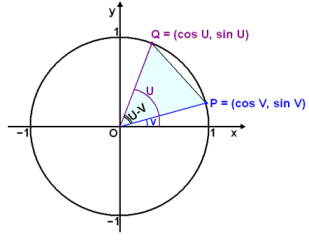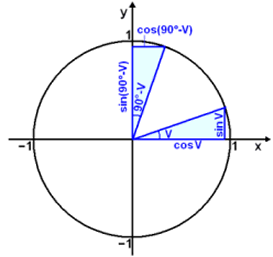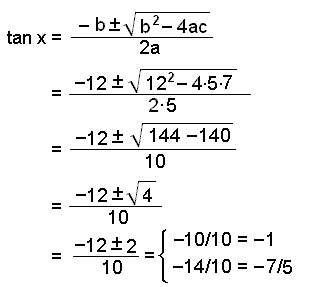© 2008 Rasmus ehf and Jóhann Ísak
© 2008 Rasmus ehf and Jóhann Ísak |
Trig Formulas |
|
The formulas for the sines, cosines and tangents of the sum or difference of two angles can be very useful. A proof of some of the rules is given here.

The triangle OPQ in the diagram has vertexes P, Q and O, the centre of the coordinate system. We will call the angle between the x-axis and OQ u, and the angle between the x-axis and OP v. The angle POQ is therefore u − v. The point Q has coordinates (cos u, sin u) and the point P has coordinates (cos v, sin v). The distance between P and Q can be written |PQ| . We now use the formula for the distance between two points to find this distance.
| |PQ|2 = (cos u − cos v)2 + (sin u − sin v)2
= cos2u − 2 cos u cos v + cos2v + sin2u − 2 sin u sin v + sin2v = 1 − 2 cos u cos v− 2 sin u sin v + 1 = 2 − 2 cos u cos v − 2 sin u sin v |
(distance)2 = (x2−x1)2 + (y2−y1)2 Multiply out of the brackets and simplify. |
Now we find |PQ| using the cosine rule.
|PQ|2 = 12 + 12 − 2×1×1×cos (u − v)
= 2 − 2×cos (u − v)
Equating these two expressions we get:
2 − 2×cos (u − v) = 2 − 2 cos u cos v − 2 sin u sin v
− 2×cos (u − v) = − 2 cos u cos v − 2 sin u sin v
If we divide all through by −2 we get the following formula:
| cos (u − v) = cos u cos v + sin u sin v |
We get a second formula from this one by putting −v in the formula instead of v:
cos (u − (−v)) = cos u cos (−v) + sin u sin (−v)
Using the rules we found from the unit circle, cos (−v) = cos v and sin (−v) = − sin v we can rewrite this expression as:
| cos (u + v) = cos u × cos v − sin u × sin v |
In the diagram below we have drawn two triangles. One has an angle v between the hypotenuse and the x-axis, the other has the same angle between the hypotenuse and the y-axis. This means that the two triangles are congruent ( exactly the same).

These congruent triangles lead to the following rules:
cos v = sin (90° − v) and sin v = cos (90° − v)
We now substitute 90° instead of u and (u + v) instead of v into these rules to get two formulas for sines.
sin (u + v) = cos (90° − (u + v))
= cos ((90° − u) − v)
= cos (90° − u) cos v + sin (90° − u) sin v
= sin u cos v + cos u sin v
In this way we have found a formula for sin (u + v):
| sin (u+v) = sin u cos v + cos u sin v | We use the rula cos(u-v) = cos u cos v+sin u sinv and then sin v = cos (90° − v) and cos v = sin (90° − v). |
If we now substitute (−v) for of v in this formula, we get the following:
| sin (u − v) = sin (u + (−v))
= sin u cos (−v) + cos u sin (−v) = sin u cos v − cos u sin v |
In this way we have found a formula for sin (u − v):
| sin (u-v) = sin u × cos v - cos u ×sin v |
By replacing v by u in the formulas sin (u + v) and cos (u + v) we get formulas for sin (u + u) and cos (u + u), called the double angle formulas. These can be written:
| sin 2u = 2 sin u × cos u
cos 2u = cos2 u − sin2u |
The rule for cos 2u can be written in two more ways by using the rule cos 2 u + sin 2 u = 1.
First we replace cos 2 u by using cos 2 u = 1 − sin 2 u and then sin 2 u using sin 2 u = 1 − cos 2 u, giving the formulas:
| cos 2u = 2 cos2 u − 1
cos 2u = 1 − 2 sin2 u |
Example 1
Use the above formulas to
find exact values for sin 15°
and cos 15°.
We have already found that
cos 45° = ![]() 2/2, sin 45° =
2/2, sin 45° = ![]() 2/2,
2/2,
cos 60° = ½ and sin 60° = ![]() 3/2. Using the formula for
3/2. Using the formula for
cos (u - v) we get the following:
cos 15° = cos (60° − 45°)
= cos 60° × cos 45° + sin 60° × sin 45°
= ½×![]() 2/2 +
2/2 +
![]() 3/2×
3/2×![]() 2/2
2/2
=
![]() 2/4 +
2/4 +
![]() 3×
3×![]() 2/4
2/4
=
![]() 2×(1 +
2×(1 +
![]() 3)/4
3)/4
Using the formula for sin (u - v) we get the following:
sin 15° = sin (60° − 45°)
= sin 60° × cos 45° − cos 60° × sin 45°
=
![]() 3/2×
3/2×![]() 2/2 − ½×
2/2 − ½×![]() 2/2
2/2
=
![]() 3×
3×![]() 2/4 −
2/4 − ![]() 2/4
2/4
=
![]() 2×(
2×(![]() 3 − 1)/4
3 − 1)/4
Example 2
Simplify the expression sin (270° − v).
We use the rule sin (u − v) = sin u × cos v − cos u × sin v.
| sin (270° − v) = sin 270° × cos v − cos 270° × sin v
= −1× cos v − 0× sin v = − cos v |
sin 270° = −1 cos 270° = 0 |
Example 3
Find a formula for cos 3x that only uses sin x and cos x.
We use the formula cos
(u + v) = cos u × cos v − sin u × sin v and replace u
by 2x and v
by x.
| cos (2x + x) = cos 2x × cos x − sin 2x × sin x | cos 2x = cos2x − sin2x sin 2x = 2 sin x × cos x |
= (cos2 x − sin2 x)×cos x − (2 sin x × cos x)×sin x
= cos3 x − sin2 x × cos x − 2 sin2 x × cos x
= cos3 x − 3 sin2 x × cos x
Example 4
Solve the equation sin 2x + 2 sin x = 0 on the interval
0| sin
2x + 2 sin x = 0 2 sin x cos x + 2 sin x = 0 2 sin x (cos x + 1) = 0 sin x = 0 og cos x = − 1. |
Use sin 2x = 2 sin x cos x. |
One solution is sin x = 0
x = 0 or ![]() (0° or 180°)
(0° or 180°)
Another solution is cos x = −1
x = ![]() (180°)
(180°)
The solutions are therefore 0, and ![]() .
.
Example 5
Solve the equation 7 cos 2 x + 5 sin 2 x + 6 sin 2x = 0
First we use the formula sin 2x = 2 sin x × cos x.
7 cos 2 x + 5 sin 2 x + 12 sin x × cos x = 0
An equation of this type, with two factors of sin or cos in each term can be solved by dividing through by cos2x and changing the equation into a tan-equation.

This is a quadratic equation with a = 5, b = 12 and c = 7.

tan x = −1 gives x
= −![]() /4 + k×
/4 + k×![]() (−45° + k×180°)
(−45° + k×180°)
tan x = −7/5 does not
give an angle that is an exact proportion of ![]() .
.
x ≈
−0.95 + k×![]() (54,5° + k×180°)
(54,5° + k×180°)
Try Quiz 1 on Trigonometry Rules.
Remember to use the checklist to keep track of your work.